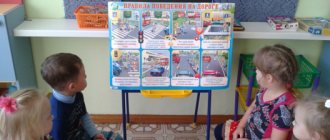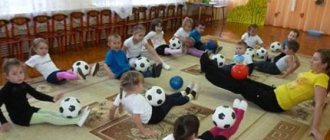Traffic rules Projects – Information and educational project “Safe Road Traffic” for children 5–7 years old
Publication “Information and educational project “Safe Road Traffic” ...” Project on traffic rules in the speech therapy group “Safe Road Traffic” Project type: informational and educational. Implementation time frame: long-term Project participants: children 5-7 years old, parents of pupils, teachers Relevance A serious problem in maintaining safe…
Socially significant project for children 6–7 years old “The ABC of Road Traffic” Passport of a socially significant project Project name: “The ABC of Road Traffic” Project type: socially significant Organization executing: MADOU MO Krasnodar “Center – Kindergarten No. 118” Project manager: teacher Dmitrieva Alvina Arkadyevna Project completion time: from...
Project on traffic rules for children of senior preschool age “My street is cheerful!” Department of Education of the Administration of the City District of Saransk MDOU "Kindergarten No. 112 of a combined type" Project on an innovative (experimental) direction of work of the teaching staff on the topic: "My cheerful street" Author - developer: teacher Amashaeva E. P....
Week-long pedagogical project “Road Safety” (senior preschool age) Kindergarten “Beryozka”, branch of the Kindergarten “Firefly” Organized educational activities Pedagogical project “Safety on the Road” (senior preschool age) Educator N.V. Peeva, teacher. Project duration: short-term (week. Project type…
Project “Safe Road” preparatory group
Project "Safe Road"
(preparatory group)
Project type:
information-oriented, group, long-term (September 2017 – May 2022)
Project participants:
children of the preparatory group, teachers, specialists, parents.
Relevance:
The relevance and simply vital necessity of teaching children the rules of the road is undeniable. Statistics show that very often children are the cause of road accidents. A child is not a small adult; his body is in a state of growth and development, and not all mental functions necessary for adaptation to the outside world are fully formed. Children are very excitable, dynamic and at the same time absent-minded, they do not know how to foresee danger, correctly assess the distance to an approaching car, its speed and their capabilities. In many ways, the safety of a pedestrian depends on his compliance with the rules of behavior on the street, so it is necessary to teach children the Rules of safe behavior on the roads through didactic games and exercises, outdoor games, and role-playing games. It is known that habits established in childhood remain for life, therefore one of the important problems in ensuring road safety is the prevention of children's road injuries in preschool institutions. Therefore, studying the Rules of the Road is one of the main tasks today, and work on a project dedicated to the study of the Rules of the Road will contribute to this.
Project idea:
- Formation in children of a model of safe behavior on roads, streets and transport, allowing them to act adequately in a specific real traffic situation.
- Raising safe behavior in preschoolers
- The development of direct perception of the surrounding world, during which children actively become acquainted with various road situations, perceiving and naming objects, phenomena, actions of people, their relationships with each other, analyzing these relationships and drawing conclusions.
Problem:
Is the child attentive on the street? Does he know the rules of conduct on the street and in transport? Does he practice the rules of the road? Does the child know how to be careful and circumspect?
Objective of the project:
- To form in children of senior preschool age the basics of safe behavior on the street, knowledge of traffic rules.
Project objectives:
- Introduce children to the rules of the road, the structure of the street and road signs intended for drivers and pedestrians;
- Develop caution and attentiveness on the road;
- Develop coherent speech in children;
- Develop safety skills;
- Continue to introduce the rules of safe behavior on the street.
When implementing the project, the integration of educational areas is carried out:
social and communicative development, cognitive development, speech development, artistic and aesthetic development, physical development.
Expected result:
- Children's acquisition of knowledge of traffic rules.
- Formation of the ability to find the right solution in a problem situation.
- Instilling a culture of behavior on the road.
- Forming a sense of responsibility for your safety and the safety of others.
- Children’s ability to negotiate and support each other.
- Encouraging children to further become familiar with traffic rules.
- Enrichment of the subject environment in the traffic rules group.
- Active participation of parents in the implementation of the project.
Project products:
work plan, development of GCD for traffic rules, children's drawings and crafts, making a city model, reminders and consultations for parents, reading fiction, didactic games.
Project implementation stages:
- Planning
- Project implementation
- Completion of the project
Main areas of work:
- Working with teachers:
- Tips from teachers
- Consultations
- Workshops
- Business games
- Open Views
- Round tables
- Work with children:
- OOD
- Conversations
- Reading fiction
- Holidays, entertainment
- Targeted walks, excursions
- Plot-didactic games
- Outdoor games, exercises, relay races
- Creating attributes for games
- Working with parents:
- Joint activities of children and parents in preschool educational institutions
- Holidays, entertainment
- Participation in drawing competitions and exhibitions
- Open days
- Joint activities of children and parents in the family
- Reading fiction
- Walking together
- Watching children's programs
- Making crafts
- Educational activities of parents in preschool educational institutions
- Questioning parents
- Recommendations, consultations
- Parent meetings
- Sliding folders
Expected results (children’s knowledge and skills):
- They know how to read information on road signs and assess the situation. Knowledge of road safety rules as a pedestrian and vehicle passenger has been developed.
- Able to make decisions independently and provide first
- medical assistance.
- An active life position of an exemplary road user has been formed.
- Children's vocabulary has been expanded.
Conclusion:
The use of this project contributes to a deeper understanding by children of traffic rules, consolidation of knowledge and skills, the formation of a conscious attitude towards their observance, the development of a sense of control, self-control, responsibility and the prerequisites for readiness to be responsible for their actions.
Every year, hundreds of traffic accidents occur on the roads of cities in our country, as a result of which dozens of children die, hundreds are injured and injured. That is why road traffic injuries remain a priority problem of society that requires solutions with everyone’s participation and the most effective methods. The first teacher who can help society solve this problem should be a kindergarten teacher. It is known that many parents have little knowledge of traffic rules and have a vague understanding of this problem. In this regard, teaching parents the rules of the road is of great importance. As mentioned above, the traffic rules are the same for children and adults. Unfortunately, they are written in “adult” language without any consideration for children. Therefore, the main task of educators and parents is to clearly explain the rules to the child, and when choosing a form of education, to convey to the children the meaning and danger of non-compliance with the rules, without distorting their content. Only through the joint efforts of educators and parents, using their knowledge, patience and tact, is it possible to teach our children the skills of safe communication with the complex world of crossing streets and roads. The proposed project is an attempt to organize in practice a system of activities for parents and teachers of preschool educational institutions to teach preschoolers the basic rules of movement and instill in them the habits and behavior of skillful and careful pedestrians. We are convinced that such a system of working to teach children traffic rules undoubtedly produces positive results; the most important thing in our project is that we were able to interest parents and children in this problem. During the implementation of this project, preschoolers became familiar with the rules of the road and safe behavior on the roads in an accessible, entertaining, playful way.
Work plan
| Month | The content of the work |
| September |
|
| October |
|
| November |
|
| December |
|
| January |
|
| February |
|
| March |
|
| April |
|
| May |
|
Long-term plan for working with parents
according to traffic rules.
September:
1. Recommendation for parents: “If you bought a bicycle for your child.”
2. Folder “We walk carefully!”
October
1. Consultation “A joint walk between children and parents.”
November:
1. Involve parents in making the “Road Signs” photo album.
2. Memo for parents “Children and the road.”
December:
1. Folder “Red, yellow, green”.
January:
1. Consultation “How to make children disciplined pedestrians.”
February:
1. Folder “Winter games outside: why are they dangerous?”
March:
1. Production by parents of costumes and attributes for theatrical games according to traffic rules.
April:
1. Exhibition of children's literature for reading according to traffic rules.
2. Folder-movable “Good road of childhood”.
May:
1. Memo “The street is the best textbook” (Rules of the road).
2. Consultations on the topic: “The example of parents is one of the main factors in successfully developing children’s skills for safe behavior on the street.”
Bibliography:
- N. N. Avdeeva, O. L. Knyazeva, R. B. Sterkina. “Safety: A textbook on the basics of life safety for children of senior preschool age” – M.: LLC Publishing House AST-LTD, 1998. – 160 p. Belaya K. Yu. Me and my safety. Thematic dictionary in pictures: The human world. – M.: School Press, 2010. – 48.
- N. N. Avdeeva, O. L. Knyazeva, R. B. Sterkina, M. D. Makhaneva “Safety on the streets and roads: A manual for working with children of senior preschool age.” – M.: LLC Publishing House AST-LTD, 1997.
- Belaya K. Yu., Zimonina V. N., Kondrykinskaya L. A. How to ensure the safety of preschool children. Notes on the basics of safety for preschool children. A book for kindergarten teachers. – M.: Education, 2004.
- Vdovichenko L. A. “Child on the street”, “Childhood-press”, 2008
- L. B. Poddubnaya “Rules of the road preparatory group”, Volgograd, “Corypheus”, 2009.
- V. N. Kiryanov “Prevention of children's road traffic injuries” methodological manual. - M., “Tritium Rome”, 2000.
- Khromtseva T. G. Education of safe behavior in the everyday life of preschool children. Tutorial. – M.: Pedagogical Society of Russia, 2005.
- Khromtseva T. G. Education of safe behavior of preschool children on the street. Textbook - M.: Center for Pedagogical Education, 2007.
Progress of the conversation:
Traffic lights were invented to regulate traffic safety on the streets. They became widespread after the invention of the automobile. Before that, there was no particular need for official traffic rules and traffic control devices: people relied more on common sense and correct behavior. But when the streets filled with fast and noisy cars, it became obvious that traffic regulation was necessary. Traffic lights, which forced some people to stop while others could move, were one way to protect cars and pedestrians from collisions and avoid traffic jams.
The first traffic light appeared in England in central London in 1868. This gas lantern, covered with red glass on one side and green glass on the other, was suspended from a high iron pole, and could be turned in one direction or the other by means of a handle mounted at its base. Of course, there were no cars at that time. But the number of steam-powered vehicles, animal-drawn carts, and pedestrians increased so much that traffic lights were needed to prevent accidents.
The electric traffic light was invented by Garrett Morgan, an African American inventor and businessman. After purchasing his first car, Morgan realized that some kind of traffic control was needed at intersections. He came up with a traffic light that worked on the same principle as the light signals installed at railway sidings . The first traffic lights had red and green lights, and when the light changed, an audible signal was heard. But as the traffic and associated noise increased, it became clear that the warning light that turned on between the "move"
and
“stand”
will be more effective than sound.
A yellow or orange signal has been added to traffic light signals to alert drivers that a stop
.
Conversation on the topic: “How to behave on the street”
Goal: to form in children an idea of safe behavior on the street.
Preparatory group. Senior preschool age. Children 6-7 years old
Project “Road ABC” in the preparatory group Municipal budgetary preschool educational institution of the Pushkin city district kindergarten No. 12 “Vasilyok”
Project Road ABC Type of project : informational and educational. Duration of the project : short-term 11.10-22.10.21 Project : pupils...
Methodological development “The best layout project for traffic rules” for children 5–6 years old
METHODOLOGICAL DEVELOPMENT: “THE BEST LAYOUT PROJECT ACCORDING TO TRAFFIC RULES ”
“A JOURNEY ALONG
THE “RIVER OF TIME”
FOR CHILDREN 5-6 YEARS OLD “FROM CARRIAGE TO CAR” EXPLANATORY NOTE A child is a rational being, he knows well the needs, difficulties and obstacles of his life. Not arbitrary orders, not...
Project "Children and the Road"
Game "Where is my place?"
Preparing for the game:
Construction of the road, placement of warnings on the road (school, cafeteria, road repair, etc.) corresponding to the studied traffic signs.
Rules of the game:
The players' task is to replace verbal warnings with the necessary signs.
The game can be played in two versions.
1. One player places the signs, the rest evaluate the correctness. 2. Two players compete to see who can place the signs faster and more correctly.
Game "Confusion".
Preparing for the game:
The teacher designs the road in advance and places the signs incorrectly (near the Zebra there is a “Slippery Road” sign, etc.).
Then he tells the children a story about how evil spirits decided to create chaos in the city; he asks for help to correct the situation. Rules of the game:
Children, having turned into good wizards, place the signs correctly. They explain what they are doing.
Game "Road Test".
Preparing for the game:
Construction of the road and placement of signs.
Rules of the game:
Child-driver-student passing the test for the right to drive a car. He “drives” along the road and, seeing this or that sign, explains what he must do. For example: there is a slippery road ahead. I slow down and drive carefully, not overtaking other cars.
Game "Guess the sign".
Preparing for the game:
All signs are placed at a distance from each other.
Rules of the game:
The teacher reads out a verbal description of what this or that sign means. Children must run to the right sign. Children who choose the sign correctly receive a token. At the end of the game, they count how many tokens they have and determine the winners.
Game “TRAVEL THROUGH THE CITY”
Program content:
introduce children to the rules of behavior on the street, in transport and in public places.
Progress of the game:
The teacher creates a game situation by introducing the fairy-tale character Pinocchio. He says that Pinocchio came to the children from another country - from Italy. He is a foreigner, he really likes it here and wants to know everything better. Today Pinocchio would like to go to the zoo to see the animals, but he does not know the way, does not know the rules of conduct in the zoo. Guys, let's help the guest. How many of you have already been to the zoo (the children say that they were not alone, but with their parents and therefore do not know the way). The teacher says: “It’s no problem, I’ll help you!” True, the trip will not be entirely real; we will travel using pictures and a layout. First, the teacher asks Pinocchio to explain what is shown in the pictures and, making sure that the children understand what will be discussed, begins the excursion.
Educator:
Imagine that the weather is sunny and beautiful, we held hands (Pinocchio will walk next to me) and left the kindergarten (shows the picture). First we went by bus to the station, then by train to Moscow. And here we are in Moscow. Cars are scurrying around. Which ones did you find out? (children name special transport they know). To get to the metro we have to take a special path for pedestrians. Who knows what it's called? (children's answer). The teacher asks to find a picture of a walking path and put it on a flannelgraph. That’s right, the pedestrian path is called a “sidewalk.” “What is the name of the road along which traffic moves?” Highway or roadway (if the children find it difficult to answer, the teacher names it himself, and the children repeat in chorus) - So we approached the metro. Please show me a picture of the subway. What is the name of the staircase that takes us underground (shows a picture). That's right, it's called an “escalator”. Next, the teacher asks the following questions: “Who controls the electric train? Who announces the stops? Who keeps order in the subway?





